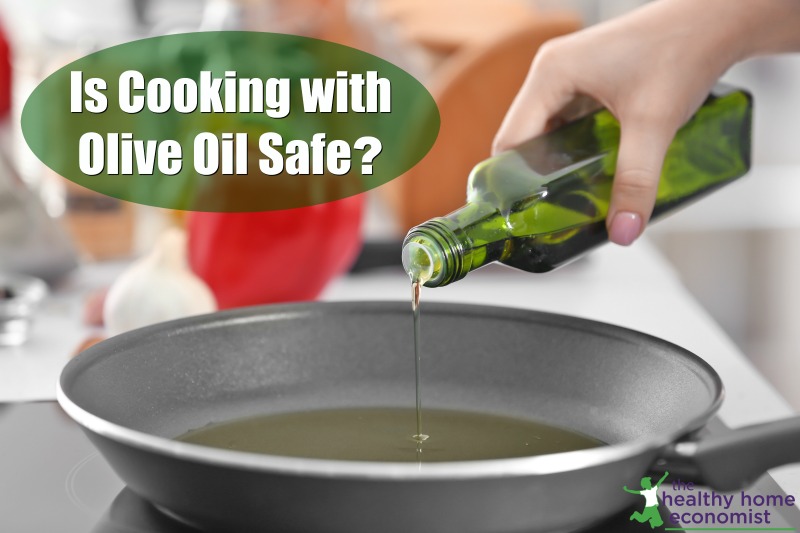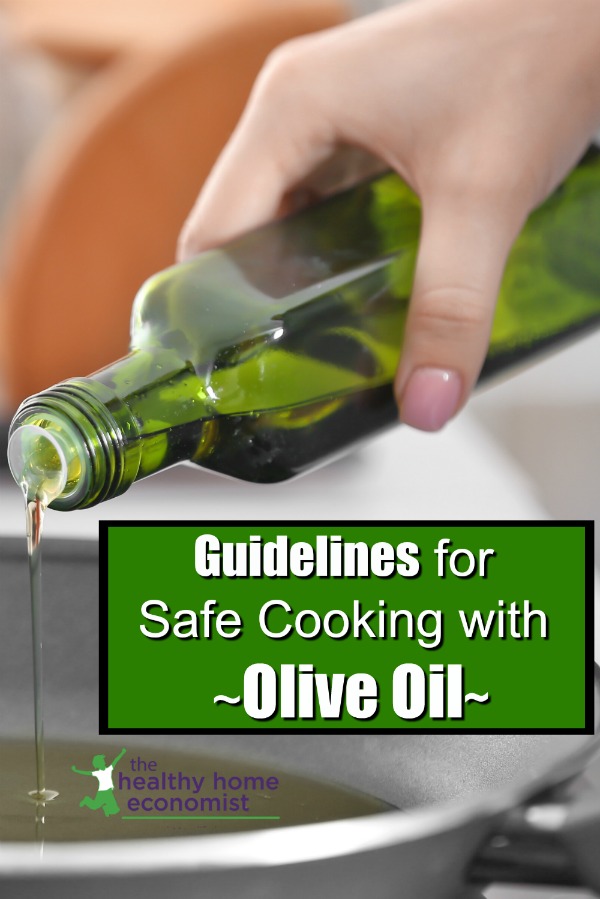Cooking with olive oil is a controversial subject with some people saying it is fine and others insisting it damages the oil. The truth falls somewhere in between, so if you prefer olive oil in your recipes, use the suggestions below as precautions to preserve nutrients.

Olives are one of the oldest foods known to man and are thought to have originated in Crete or Syria some 6000 years ago. The golden color of the rich oil pressed from tree-ripened olives has been consumed by healthy traditional cultures since as early as 3000 BC.
Olive oil especially the first Fall harvest known as Olio Nuovo is truly one of the crown jewels of fats and what I always buy.
Olive oil is primarily composed of oleic acid, which is monounsaturated fat. Monounsaturates are one of the three main categories of fats. The other two are saturated fats and polyunsaturated oils.
The three types of fats – do you know how to tell the difference?
Saturated fats like coconut oil and tallow, are extremely stable because they pack together tightly courtesy of very straight carbon bonds that are all occupied by hydrogen atoms. Saturated fats are solid or semisolid at room temperature and make ideal cooking fats because of the inherent stability provided by their chemical structure which means that they do not easily go rancid when heated during cooking or form the free radicals that contribute to heart disease and cancer.
Polyunsaturated fats do not pack together as tightly as saturated fats and hence are liquid at room temperature and remain so even if refrigerated. The chemical structure of polyunsaturated oils is such that there are unpaired electrons for every carbon-carbon double bond which are highly reactive if heated or processed in any way. Even simple exposure to the air or light can cause rancidity in fairly short periods of time. Grapeseed oil is a fat that is extremely high in polyunsaturates.

Monounsaturated fats like olive, canola, and avocado oil are liquid at room temperature yet become semi-solid if refrigerated. Sesame oil has very similar levels of mono to polyunsaturated fat.
The single carbon-carbon double bonds which make up the chemical structure of monounsaturated fats do not pack together as tightly as saturated fats but are more tightly bound than those of polyunsaturated oils.
Monounsaturated fats do not go rancid as easily as polyunsaturated oils but are more delicate than saturated fats due to a slight molecular bend which is not as straight in shape as the carbon bonds in a fully saturated molecule.
Now that we understand the basic structure of the 3 types of fats, it is easy to identify the type of fat that primarily composes an oil as this can be ascertained by simply observing its form at either room temperature or when refrigerated.
If a natural fat is solid or semisolid at room temperature, then it is primarily saturated. If it is fully liquid at room temperature but goes solid in the refrigerator, it is primarily monounsaturated, and if it is liquid when either refrigerated or at room temperature, it is mostly polyunsaturated.
With proper identification of the kinds of fats now complete, let’s turn our attention to the proper cooking oils.
Cooking with what fats – when?
It is clear that fats that are primarily saturated like tallow, coconut or palm oils are wonderful for cooking as the heat from cooking does not easily damage them or form free radicals.
On the other hand, polyunsaturated oils like sunflower, corn, grapeseed, soy or safflower should be strictly avoided for cooking as they are too easily damaged as those free electrons react too easily with heat or oxygen.
But what about monounsaturated fats, in particular, olive oil? This is where the issue gets a bit murky.
It is absolutely true that cooking with olive oil will not form trans fats. Even higher heat cooking with olive oil will not cause much free-radical creation although I would venture to say that there are certainly some free radicals formed when high heat cooking with monounsaturates due to the slightly less stable structure as compared with saturated fats.
I personally choose to avoid cooking with olive oil, especially extra virgin olive oil (EVOO). For one thing, good quality EVOO is quite expensive and should be properly packaged in dark-colored glass to protect the delicate nutrients. Studies have shown that light quickly degrades the quality of extra virgin olive oil.
Research shows that only two months’ exposure to light caused free radical increases in extra virgin olive oil to such a level that it could no longer be classified as extra virgin!
With light so easily damaging to extra virgin olive oil, it seems obvious that heat and cooking would damage it as well and studies bear this out. Heat as low as 350F (180C) can significantly damage the beneficial phenols in olive oil. Phenolic substances are highly anti-inflammatory in nature and likely an important reason why studies of the Mediterranean Diet which is high in olive oil have indicated a decrease in heart disease risk.
As a result, it seems prudent that even though cooking with olive oil does not produce any transfats or much free radical damage, it does reduce much of the beneficial aspect of consuming this healthy traditional oil in the first place.
Light saute cooking with olive oil at temperatures no higher than 200-250F seems to be safe and minimally damaging. However, oven baking or higher heat cooking on the stovetop with olive oil is not wise given that there are much hardier and less expensive fats to choose from like expeller-pressed coconut oil or palm oil!
By far, the best use of good quality, nutrient-loaded extra virgin olive oil is as a salad dressing. Combining one part vinegar or lemon juice with between 3-5 parts oil along with a drizzle of walnut oil and flavoring herbs of choice will provide a truly healthy topping for any salad or vegetable mix.
A Word of Caution for Olive Oil Lovers
While numerous studies have shown the beneficial effect of olive oil in the diet likely due to the anti-inflammatory nature of the phenols, it is advisable to go easy on this traditional fat if weight loss is your goal.
In 1994, the journal The Lancet published a study which noted that fat tissue is primarily composed of monounsaturated fat. Could this be a contributing reason for middle-age weight gain that is so common in Mediterranean countries (Eat Fat Lose Fat, p.70)?
The chemical structure of monounsaturated oils could be part of the problem. Monounsaturates like those found in olive oil are composed of longer chain fatty acids unlike the short and medium-chain fatty acids found in coconut oil, palm oil, butter, and other animal fats.
Short and medium-chain fatty acids are absorbed quickly and directly by the body for immediate energy whereas the longer chain fatty acids must be acted upon by bile salts to be digested. For this reason, longer chain fatty acids are more likely to contribute to weight gain.
Where to Find Quality Extra Virgin Olive Oil
It is important to realize that much of the conventional olive oil on the market isn’t even olive oil at all, according to Tim Mueller, an investigative journalist who has written a book on the subject called Extra Virginity: The Sublime and Scandalous World of Olive Oil. If you suspect your olive oil is fake, put it in the refrigerator to see if it properly solidifies. Another test is to see if your extra virgin olive oil can keep a wick burning. Refined oils masquerading as extra virgin olive oil cannot typically hold a flame very well.
Unfortunately, neither of these tests can completely guarantee authenticity.
To be sure of the quality of your extra virgin olive oil, check this vetted source that comes directly from the olive oil farms themselves. These small farms are also working to preserve heirloom olive tree varieties being rapidly destroyed to make room for more corporate-friendly groves.
More Information
Extra Virgin Olive Oil Like You’ve Never Seen or Tasted Before
Traditional and Unusual Uses for Olive Oil
Liver and Gall Bladder Cleanse Using Olive Oil
Selecting a Healthy Cooking Oil and Reusing it Safely
The Truth About Pumpkin Seed Oil
Is Rice Bran Oil a Healthy Fat?
Caution When Using Chicken Fat for Cooking
How Vegetable Oils Make Us Fat
How Argan Oil Benefits Health
Red Palm Oil Benefits Rival Coconut Oil
Walnut Oil: Healthy Sub for Flax Oil
Picture Credit








I use a pressure cooker for tougher cuts of beef and lamb – things that would once have been slowly cooked in the oven or on the stove top.
What is the best form of fat to use for this type of cooking?
How does pressure cooking affect olive oil?
I use very few oils in cooking and olive oil is reserved for salad dressings. Since I started using home-rendered lard and good butter (no added cultures) for cooking, not only has the flavour of my food improved but I am healthier, fitter and losing weight. Nut-based oils are bad for you.
I just got back from a trip to the island of New Britain in Papua New Guinea. The native birds and trees on the island have been almost completely displaced by the huge palm trees that have been planted for palm oil. The trees only live 10 or 15 years. The soil by then has been so depleted of nutrients that no other crops can be grown. The same thing is happening in Ecuador. Since most our oxygen comes from trees, these plantations are not only destroying habitat, they are endangering our lives.
Coconut oil has a very high concentration of saturated fat (92%), and saturated fat increases LDL cholesterol level.
I wouldn’t suggest coconut oil as being an ideal fat to cook with.
If you’re concern with fat going bad, the trick is to store it at the right temperature and away from light source, and obviously, don’t use it after a certain period of time depending on the type of the fat. Also, don’t heat up fat close to its smoking point.
Suggesting fats that contain very high amount of saturated fat is a poor advice to give.
It seems that you missed the memo that saturated fats aren’t bad! And, in fact, those that eat it suffer FEWER strokes and other health problems than those who don’t. So many studies are showing variations of this message over the past decade or so. Here’s the latest. https://www.sciencedaily.com/releases/2018/07/180711182735.htm
So, it boils down to price essentially? Is that correct?
I feared for awhile that it may cause free radical damage or rancid it’s when cooked! I have been avoiding it like it is canola oil. So no need to fear, then, phew
Yes, price but be sure the extra virgin olive oil you buy is authentic! There are a lot of brands calling themselves extra virgin olive oil when in fact it is a blend of EVOO and a cheap filler oil like canola or soy oil.
I have been having digestive issues and my next best guess is that cooking with olive oil is causing inflammation and digestive problems.
I am going to switch to cooking with water instead for a couple weeks.
Thanks for the article 🙂
So, cooking with olive oil is OK, just not as beneficial? I prefer to use butter or lard, but my partner is keen on the liquids, especially for roasting, but I haven’t been sure what to let him use, and he’s getting frustrated. Also, we don’t have a lot of options in our Far West town (olive, grapeseed, and maybe one other).